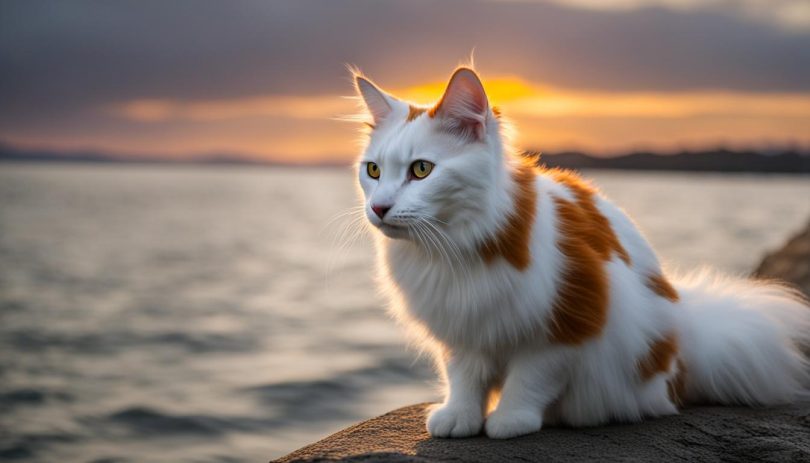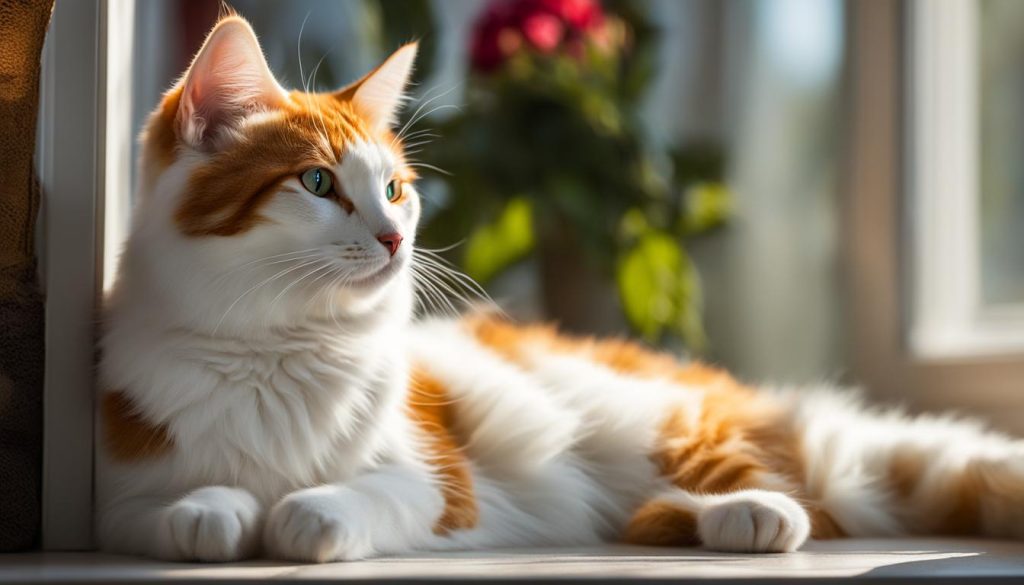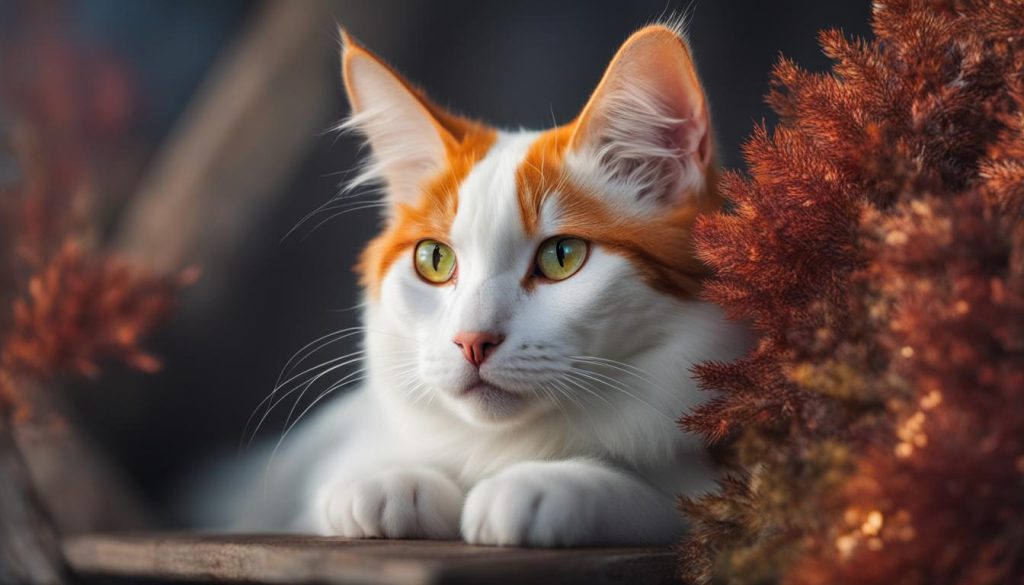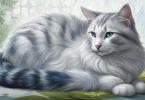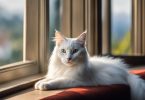Hello, cat lovers! Today, I want to introduce you to the mesmerizing world of the Turkish Van cat. If you’re looking for a breed that’s as elegant as it is effervescent, then the Turkish Van cat is sure to capture your heart. Originating from the eastern part of Turkey, this breed is known for its striking appearance, distinctive coloring, and fascinating characteristics.
Key Takeaways:
- The Turkish Van cat is a breed of cat known for its unique beauty and striking appearance.
- Originating from Turkey, this breed has a rich history and cultural significance.
- Turkish Van cats are known for their love of water, substantial size, and full-bodied coat.
- They have a unique pattern of color on their heads and tails, called the “Van pattern”.
- The Turkish Van cat has a lively, playful, and intelligent personality, making them a delightful addition to any home.
Origins of The Turkish Van Cat
The Turkish Van cat breed originates from the rugged, mountainous regions of Eastern Turkey, particularly the Lake Van area. These cats are named after the region that inspired their breed name. According to legends, Turkish Van cats had a unique journey that connects them to the famous story of Noah’s Ark. It is believed that the cats ventured aboard the Ark and were among the first to disembark, which resulted in their distinctive coloring.
The journey of Turkish Van cats to widespread popularity began when two British photographers, Laura Lushington and Sonia Halliday, received a pair of these cats as a gift during their travels in Turkey. Intrigued by these unique felines, they brought them back to England in the late 1950s. This marked the beginning of a focused breeding program to preserve the breed’s unique characteristics.
Today, Turkish Van cats are recognized and celebrated for their striking appearance, love of water, and playful nature. Their origins and journey from the mountains of Turkey to becoming a cherished breed worldwide add to their allure and charm.
Historical Timeline of Turkish Van Cats
| Year | Event |
|---|---|
| 1955 | Laura Lushington and Sonia Halliday receive Turkish Van cats as a gift in Turkey. |
| 1959 | Lushington and Halliday bring the cats to England. |
| 1969 | The Governing Council of the Cat Fancy (GCCF) grants official recognition to the Turkish Van breed in the United Kingdom. |
| 1979 | The Cat Fanciers’ Association (CFA) grants official recognition to the Turkish Van breed in the United States. |
| 1993 | The International Cat Association (TICA) grants official recognition to the Turkish Van breed worldwide. |
Physical Characteristics and Health Considerations
When it comes to physical characteristics, Turkish Van cats are truly a sight to behold. They have a semi-longhaired coat that is predominantly white in color, with splashes of color on their heads and tails known as the “Van pattern.” This unique coloration sets them apart from other breeds and adds to their charm. Additionally, Turkish Van cats have captivating eyes, often exhibiting odd-colored eyes, with one blue and one amber eye being quite common. Their eyes are truly mesmerizing and add to their overall beauty.
In terms of their body structure, Turkish Van cats are known for their broad-chested and muscular bodies. They have a substantial size, with males typically weighing between 10 to 20 pounds and females weighing between seven to 12 pounds. Their muscular build gives them a strong and athletic appearance. Another distinctive trait of Turkish Van cats is their love for swimming. Unlike most cats, they have a fondness for water and are often seen splashing around or even swimming in it. This unique characteristic sets them apart from other feline companions.
When it comes to their health, Turkish Van cats are generally robust and healthy. They have minimal breed-specific ailments and can live a long and fulfilling life with proper care. However, it is important to be aware of certain health considerations. Regular check-ups with a veterinarian are recommended to ensure their well-being. Although not common, conditions such as hypertrophic cardiomyopathy (HCM) can affect Turkish Van cats, so periodic screening is advised. Additionally, regular grooming is necessary to prevent matting and hairball formation due to their semi-longhaired coat.
| Turkish Van Cat Physical Characteristics | Turkish Van Cat Health Considerations |
|---|---|
| Distinctive “Van pattern” coloring on head and tail | Regular veterinary check-ups recommended |
| Odd-colored eyes, often with one blue and one amber eye | Screening for conditions like hypertrophic cardiomyopathy (HCM) advised |
| Broad-chested and muscular body structure | Regular grooming required to prevent matting and hairballs |
| Affinity for swimming and water | Overall robust health with minimal breed-specific ailments |
The physical characteristics of Turkish Van cats, from their striking “Van pattern” coloring to their captivating eyes and muscular build, make them truly unique and beautiful companions. Their love for water sets them apart from other feline friends and adds an element of excitement and playfulness to their personality. With proper care and regular veterinary attention, Turkish Van cats can enjoy a healthy and fulfilling life.
Conclusion
Turkish Van cats possess a rare combination of physical beauty, distinctive coloring, and unique personality traits. Their semi-longhaired coat, odd-colored eyes, and affinity for water make them stand out among other cat breeds. With their robust health and minimal breed-specific ailments, Turkish Van cats can bring joy and companionship to their owners for many years. By understanding their physical characteristics and health considerations, you can ensure their well-being and provide a loving and enriching environment for these extraordinary feline companions.
Behavior and Temperament
When it comes to the behavior and temperament of Turkish Van cats, they are truly one-of-a-kind. These cats are known for their lively and playful nature, making them a constant source of entertainment for their owners. They are intelligent creatures with a curious streak, always exploring their surroundings and seeking new adventures. Whether it’s climbing to high places or investigating every nook and cranny of your home, Turkish Van cats will keep you on your toes.
Despite their independent nature, Turkish Van cats are surprisingly affectionate towards their human companions. They have a unique way of showing their love and can often be found cuddling up to their owners or following them around the house. Their social nature makes them great companions for families and individuals alike.
One of the most interesting traits of Turkish Van cats is their love for water. They have a natural affinity for swimming and are often referred to as the “swimming cats.” If you have a Turkish Van cat, don’t be surprised to find them frolicking in the bathtub or playing with water from a faucet. This unique behavior adds to their charm and makes them a truly fascinating breed.
Notable Characteristics
Here are some key characteristics that set Turkish Van cats apart:
- Playful and intelligent nature
- Affectionate towards their human companions
- Curious and exploratory
- Love for water and swimming
“Turkish Van cats are not only beautiful but also incredibly entertaining with their playful antics and love for water. They bring so much joy to our lives!” – Turkish Van cat owner
Caring for a Turkish Van Cat: At a Glance
| Aspect | Tips |
|---|---|
| Nutrition | Provide a balanced diet tailored to their needs and monitor portion control. |
| Grooming | Regular brushing, dental care, ear cleaning, and nail trimming are essential for their coat maintenance. |
| Exercise and Mental Stimulation | Engage in interactive play sessions, provide vertical spaces, and use puzzle toys for mental stimulation. |
By following these guidelines and giving your Turkish Van cat the care it deserves, you can enjoy a loving and rewarding bond with your feline companion.
Turkish Van Cat Price
When considering adding a Turkish Van cat to your family, it’s essential to understand the potential cost involved. The price of a Turkish Van cat can vary depending on several factors, including the breeder’s reputation and location, the cat’s lineage, and the current demand for the breed. Generally, Turkish Van kittens can range from a few hundred to a few thousand dollars.
It’s important to do thorough research and find a reputable breeder who prioritizes the health and well-being of their cats. While the cost may be higher with a reputable breeder, you can have peace of mind knowing that your Turkish Van comes from a responsible and ethical source. Additionally, adopting from a shelter or rescue organization is another option to consider, as it can be a more affordable way to bring a Turkish Van cat into your home while giving a deserving cat a second chance.
Remember, when considering the price of a Turkish Van cat, it’s crucial to factor in the long-term expenses of cat ownership. This includes routine veterinary care, vaccinations, spaying or neutering, grooming supplies, high-quality cat food, and other necessities. By planning ahead and being prepared for the financial commitment, you can provide a loving and comfortable home for your Turkish Van cat.
| Breeder Reputation | Location | Lineage | Price Range |
|---|---|---|---|
| Reputable breeder | Urban area | Purebred with pedigree | $1,000 – $3,000+ |
| Reputable breeder | Rural area | Purebred with pedigree | $800 – $2,500+ |
| Reputable breeder | Any location | Purebred without pedigree | $500 – $1,500+ |
| Shelter or rescue organization | Any location | Varies | $100 – $500 |
Turkish Van Cat Information
If you are considering adding a Turkish Van cat to your family, it’s essential to gather all the necessary information about this unique breed. Turkish Van cats are known for their striking appearance, playful temperament, and love for water. To ensure you provide the best care for your Turkish Van, here is some important information you should know:
“Turkish Van cats have a unique history and cultural significance. They are deeply rooted in Turkish folklore and tales, making them a truly special breed.”
Characteristics of Turkish Van Cats
Turkish Van cats are known for their distinctive physical traits. They have a semi-longhaired coat, which is predominantly white in color. The van pattern, a term used to describe the splashes of color on their head and tail, adds a touch of uniqueness to their appearance. Another striking feature of Turkish Van cats is their captivating eyes. It is common for them to have odd-colored eyes, with one eye being blue and the other amber.
In terms of their temperament, Turkish Van cats are lively, playful, and intelligent. They have a curious nature and love exploring their surroundings. Despite their active nature, they also display affection towards their human companions, making them excellent family pets.
Finding Turkish Van Cat Breeders
When looking for a Turkish Van cat, it’s important to find a reputable breeder who prioritizes the health and well-being of their cats. A good breeder will provide you with valuable information about the breed, including their specific care requirements, health considerations, and behavioral traits. They will also assist you in finding a suitable Turkish Van kitten that matches your preferences.
Additionally, consider adopting a Turkish Van cat from a shelter or rescue organization. This not only gives a deserving cat a loving home but also allows you to contribute to animal welfare.
| Key Facts about Turkish Van Cats | |
|---|---|
| Origin | Eastern Turkey |
| Coat | Semi-longhaired, predominantly white with splashes of color |
| Temperament | Lively, playful, and affectionate |
| Eye Color | Odd-colored eyes, commonly blue and amber |
| Size | Medium to large |
| Lifespan | 12 to 17 years |
By understanding the unique qualities of Turkish Van cats and gathering information from reputable breeders, you can ensure a joyful and fulfilling experience with your Turkish Van companion.
Turkish Van Cat Colors
The Turkish Van cat is renowned for its striking appearance, which is enhanced by the unique colors found in its coat. The most distinctive feature of the Turkish Van cat’s coat is the “Van pattern,” which consists of splashes of color on the head and tail. These patches can vary widely in color, and almost all color combinations are acceptable within the breed. Some common colors seen in Turkish Van cats include red, brown, blue, cream, and black.
The Turkish Van cat’s coat is predominantly white, with the colored patches adding a touch of vibrancy and contrast. The coloring can vary in intensity, with some cats having bold and distinct patches, while others may have more subtle markings. The combination of the white coat and colorful patches gives the Turkish Van cat a truly eye-catching appearance.
The Turkish Van cat’s coat is semi-long and has a unique texture resembling cashmere, which adds to its allure. The coat acts as a natural waterproofing layer, keeping the cat dry even when it is in water. This is particularly beneficial for a breed known for its love of water and swimming. The Turkish Van cat’s coat requires regular grooming, including brushing to prevent matting and the formation of hairballs.
| Color | Description |
|---|---|
| Red | A rich and vibrant shade of red, adding warmth to the cat’s appearance. |
| Brown | A deep and earthy color, ranging from light brown to a darker chocolate shade. |
| Blue | A soft and subtle shade of bluish-gray, adding a touch of coolness to the coat. |
| Cream | A pale and creamy color, giving the cat an elegant and delicate look. |
| Black | A solid and intense black color, creating a striking contrast against the white coat. |
“The Turkish Van cat’s coat is a beautiful canvas of colors, with each cat showcasing a unique and captivating combination. From the boldness of red and black to the subtlety of cream and blue, the Turkish Van cat’s coat truly represents the breed’s individuality and charm.” – Turkish Van Cat Breeder
Nurturing the Beauty of the Turkish Van Cat’s Coat
To maintain the beauty of a Turkish Van cat’s coat, regular grooming is essential. This includes brushing their semi-long hair to prevent tangles and matting. Additionally, it is important to provide them with a balanced diet rich in nutrients to promote healthy skin and coat. Adequate hydration is also crucial, as it helps to maintain the coat’s natural luster.
Furthermore, protecting the Turkish Van cat from excessive exposure to the sun can help prevent the fading of their coat colors, ensuring that they maintain their vibrant appearance throughout their lives. By dedicating time and attention to the grooming and care of a Turkish Van cat’s coat, owners can help them shine with their unique and beautiful colors.
Turkish Van Cat Size and Weight
The Turkish Van cat is a medium to large-sized breed compared to other cats. It has a slow maturity rate, and it takes three to five years for them to reach their full size. Healthy male Turkish Vans can weigh between 10 to 20 pounds, while healthy females generally weigh between seven to 12 pounds.
Monitoring the weight of your Turkish Van cat is important to ensure they maintain a healthy size. If you have concerns about your cat being underweight or overweight, it’s best to consult with a veterinarian. They can provide guidance on proper nutrition and exercise to help your Turkish Van maintain an ideal weight.
Here’s a visual representation of the average size and weight range for Turkish Van cats:
| Gender | Average Weight (Pounds) |
|---|---|
| Male | 10 – 20 |
| Female | 7 – 12 |
Note: Individual Turkish Van cats may vary in size and weight, and these numbers are meant to provide a general range.
By monitoring the size and weight of your Turkish Van cat and providing them with proper care, you can ensure their overall health and well-being.
Turkish Van Cat Lifespan
The lifespan of Turkish Van cats, like many cat breeds, can vary depending on various factors. On average, these beautiful felines live between 12 to 17 years. However, with proper care, love, and attention, Turkish Van cats have the potential to enjoy a long and fulfilling life.
As with any pet, providing a healthy and balanced diet, regular veterinary check-ups, and a safe environment are essential for promoting longevity. Additionally, mental and physical stimulation through playtime, interactive toys, and engaging activities can contribute to their overall well-being.
While Turkish Van cats are generally healthy and resilient, it is important to be mindful of their specific health needs. Regular grooming, dental care, and monitoring for any signs of illness or discomfort are crucial in ensuring their optimal health and happiness. By being a responsible and attentive owner, you can help your Turkish Van cat thrive throughout their lifespan.
Conclusion
In conclusion, the Turkish Van cat is truly a remarkable breed that captures the hearts of cat lovers worldwide. With its striking appearance and unique personality, this breed offers a one-of-a-kind pet ownership experience. From their love for water and playful nature to their rich history and cultural significance, Turkish Van cats bring a touch of elegance and charm to any household.
Understanding the specific needs of Turkish Van cats is crucial in providing them with a fulfilling and healthy life. From balanced nutrition and mental stimulation to regular grooming and veterinary care, these beautiful felines thrive in a well-rounded environment. By embracing their love for exploration and water, owners can forge a deep and rewarding connection with their Turkish Van companion.
Whether you are captivated by their striking colored patches, their playful antics, or their unique ability to swim, the Turkish Van cat is a breed that leaves a lasting impression. By welcoming a Turkish Van into your home, you embark on a journey filled with love, companionship, and beautiful memories that will last a lifetime. The Turkish Van cat truly is a treasure to behold.
FAQ
What is the history of the Turkish Van cat?
The Turkish Van cat originated in the rugged, mountainous regions of Eastern Turkey, particularly the Lake Van area. Legends suggest they ventured aboard Noah’s Ark and were among the first to disembark, resulting in their distinctive coloring.
What are the physical characteristics and health considerations of Turkish Van cats?
Turkish Van cats have a predominantly white coat with splashes of color on the head and tail, known as the “Van pattern”. They have broad-chested and muscular bodies, and their eyes can be odd-colored, with one blue and one amber eye being common. In terms of health, they are generally robust, but screening for certain conditions like hypertrophic cardiomyopathy (HCM) is recommended.
What is the behavior and temperament of Turkish Van cats like?
Turkish Van cats are described as lively, playful, and intelligent. They are curious and love to explore their surroundings. They have a unique interest in water and are known as the “swimming cat”. They are also known for their surprising affection towards their human companions and have a distinct way of communicating through soft trills, chirps, and purrs.
How do I care for a Turkish Van cat?
Caring for a Turkish Van cat involves providing high-quality cat food, monitoring their weight, providing mental stimulation and exercise, and ensuring access to water. Regular grooming is also necessary, including brushing, teeth brushing, ear cleaning, and nail trimming.
How much does a Turkish Van cat cost?
The price of a Turkish Van cat can vary depending on factors such as the breeder, lineage, location, and demand. Generally, Turkish Van kittens can range from a few hundred to a few thousand dollars.
Where can I find more information about Turkish Van cats?
Turkish Van cat breeders can provide valuable information about the breed and assist in finding a suitable kitten. Additionally, researching online or reaching out to reputable cat organizations can provide more information about Turkish Van cats.
What colors do Turkish Van cats come in?
Turkish Van cats have a predominantly white coat with splashes of color on the head and tail. Almost all color combinations are acceptable within the breed, including red, brown, blue, cream, and black.
How big do Turkish Van cats get?
Turkish Van cats are medium to large in size compared to other breeds. Healthy males can weigh between 10 to 20 pounds, while healthy females weigh between seven to 12 pounds. They have a slow maturity rate and take three to five years to reach full size.
How long do Turkish Van cats live?
Turkish Van cats have a lifespan similar to many cat breeds, living an average of 12 to 17 years. With proper care and a healthy lifestyle, they can enjoy a long and fulfilling life.
Can you summarize the uniqueness of Turkish Van cats?
Turkish Van cats are known for their striking appearance with a predominantly white coat and splashes of color. They have a love for water, playful personality, and surprising affection towards their human companions. Caring for them involves understanding their specific needs, providing mental and physical stimulation, and ensuring their well-being.
